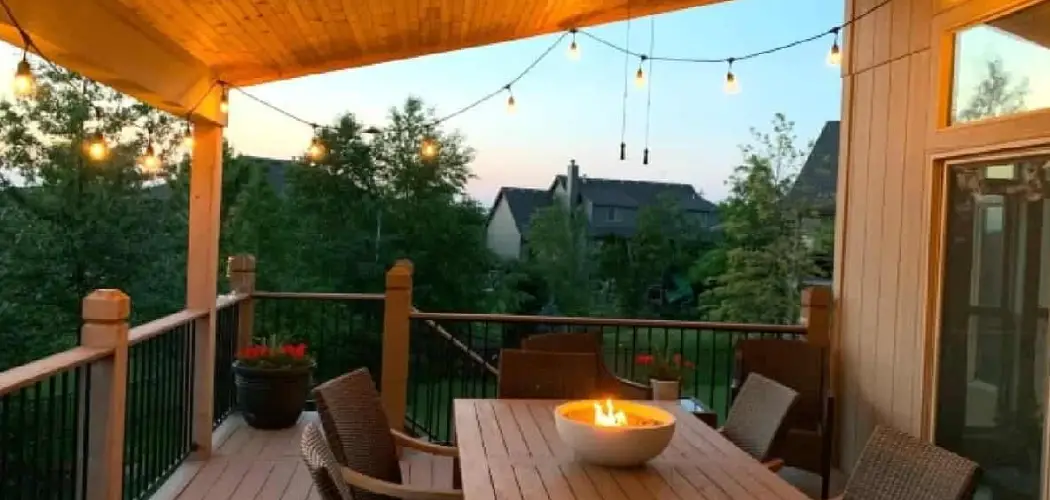Hanging patio lights can transform your outdoor space into a magical haven for evening gatherings or peaceful retreats. However, many people are reluctant to drill holes or use nails that might damage their exterior walls or structures. Fortunately, there are several alternative methods to hang patio lights without compromising the integrity of your surfaces. These methods not only ensure a secure installation but also maintain the aesthetics of your outdoor area. In this guide, we’ll explore how to hang patio lights without nails with ease and creativity.
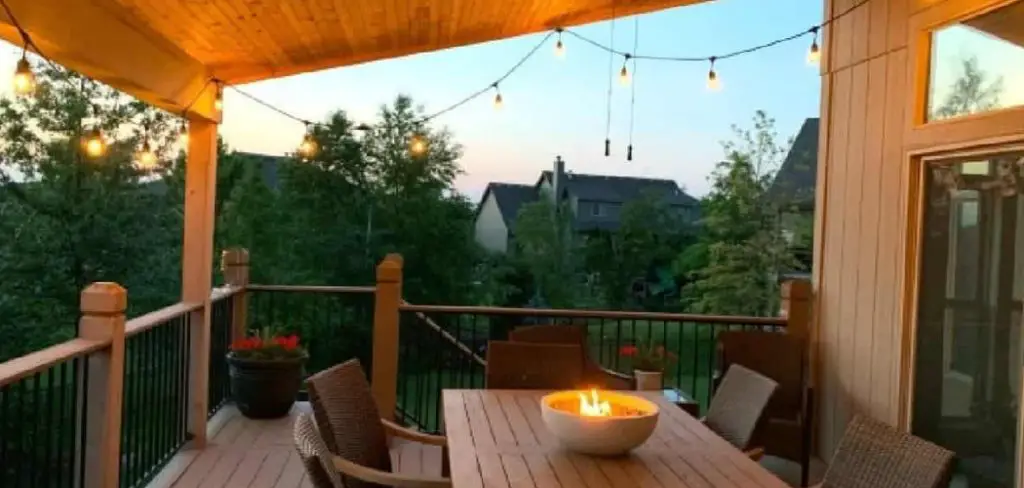
Why Avoid Nails When Hanging Patio Lights
Avoiding nails when hanging patio lights comes with several advantages that extend beyond merely preserving the integrity of your walls or structures. Firstly, using nails can create permanent damage, leaving unsightly holes that may lead to moisture infiltration or deterioration over time. This can result in costly repairs and compromise the overall durability of your exterior finishes.
Secondly, nails can limit your flexibility and creativity, making it difficult to change or reposition your lighting arrangement without leaving marks behind. Lastly, for renters or those concerned with homeowner association regulations, using alternative methods offers a non-invasive solution that upholds property agreements while allowing for personalized and stylish décor enhancements.
Common Tools and Accessories
When it comes to hanging patio lights without using nails, equipping yourself with the right tools and accessories is essential. Here are some of the most commonly used options:
- Adhesive Hooks: These versatile hooks come with a strong adhesive backing that sticks to smooth surfaces like wood, metal, or vinyl. They are easy to apply and remove without causing damage, making them ideal for temporary setups.
- Wire Clips and Cable Ties: Wire clips can be attached to surfaces with adhesive or clips, allowing you to secure light strings without nails. Cable ties are another non-invasive option, perfect for fastening lights to poles, railings, or other structures.
- Gutter Hooks: Designed specifically to hang lights along gutters, these hooks easily attach to the edge of a gutter without any need for tools. They’re perfect for hanging lights along the roofline or around certain outdoor structures.
- PVC pipe or Tension Rods: These can be used to create a framework for hanging lights. By positioning them between two stable points, you can string the lights along the rods, preventing any need for nails.
- Zip Tie Mounts: Combined with zip ties, these mounts can be adhered to various surfaces to secure your patio lights in place. They’re excellent for non-permanent installations and easy repositioning.
Utilizing these tools not only protects your walls and structures from damage but also offers flexibility and creativity in your lighting arrangements.
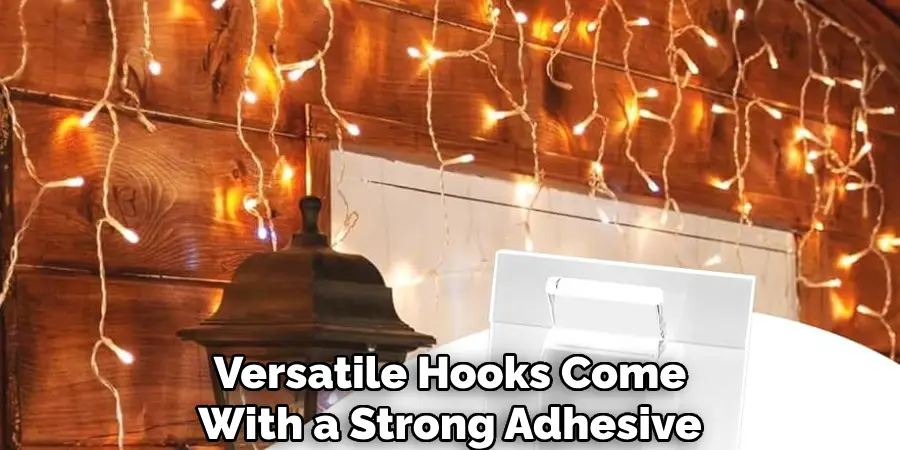
10 Creative Ways How to Hang Patio Lights without Nails
Patio lights can transform your outdoor space into a magical retreat perfect for gatherings or a quiet evening alone. But if you’re a homeowner wary of damaging your siding or a DIY enthusiast looking for innovative solutions, hanging those lights without nails is the way to go. This listicle provides ten clever methods to install patio lights while maintaining the integrity of your walls and creating a captivating ambiance.
1. Use Adhesive Hooks
Adhesive hooks are an excellent option for lightweight patio lights. They’re easy to install and remove without leaving marks. Simply clean the surface, stick the hooks at regular intervals, and hang your lights. Brands like Command Hooks offer weather-resistant options suitable for outdoor use and can hold up to 5 pounds—a perfect choice for string lights.
2. Opt for Gutter Hooks
If you have gutters around your patio, gutter hooks make for a quick and efficient solution. They easily clip onto the gutter’s edge, providing a secure place to hang your lights. This method is particularly useful for multi-story homes where reaching the upper walls can be challenging. Just ensure your hooks are spaced evenly to maintain a neat appearance.
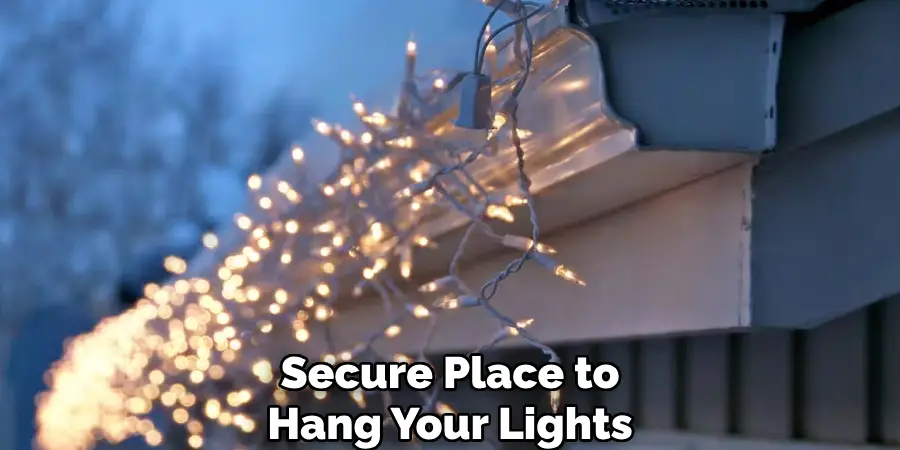
3. Utilize Zip Ties
Zip ties are versatile and sturdy, making them ideal for heavier lighting. You can loop them through objects like railings or trellises, securing your lights in place. They’re especially useful for permanent installations, as they withstand various weather conditions. Just use scissors to cut off any excess ties for a clean finish.
4. Employ Wire Fencing
For a more permanent fixture, consider installing wire fencing along your patio edges. You can weave string lights through the wire for a sleek look. It’s a great way to maintain an organized setup while ensuring your lights stay put during windy days. Plus, the fencing can serve multiple purposes, like supporting climbing plants.
5. Try Magnetic Clips
Magnetic clips work wonders on metal surfaces like frames or gutters. They provide a strong hold without drilling or sticking. Simply attach them where needed, and hang your lights effortlessly. These are particularly useful for temporary setups or seasonal lighting displays.
6. Go with S Hooks
S Hooks are a handy solution for hanging lights from overhead structures or beams. Their open-ended design allows you to adjust the length and placement of your lights easily. They’re reusable and can be relocated anytime, making them perfect for those who enjoy rearranging outdoor décor.
7. Use Drilling Alternatives
If you’re open to minor alterations, consider using small cup hooks that require minimal drilling. They’re low-impact, easily removable, and provide excellent support. Alternatively, screw-in hooks can be partially installed and covered when not in use, reducing visible impact on your structures.
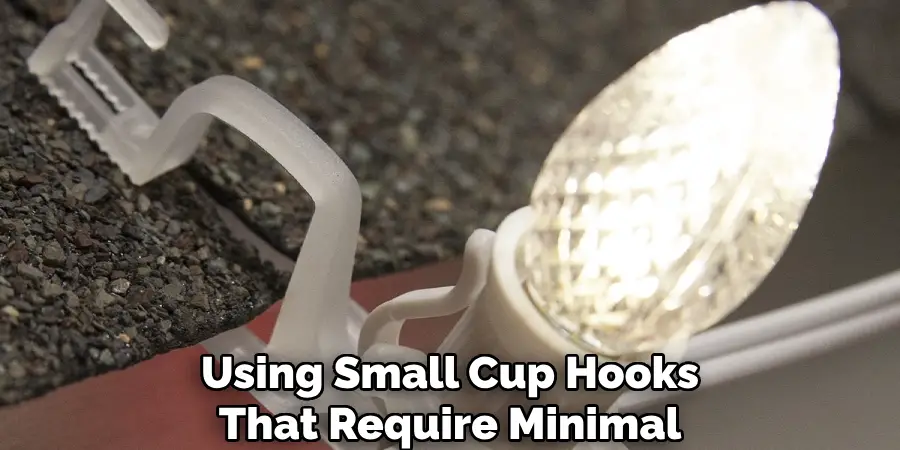
8. Leverage Trees or Vegetation
Your garden can naturally support patio lights. Wrap or drape your lights around tree trunks or branches for a whimsical touch. This method not only enhances your outdoor environment but also integrates lighting in an eco-friendly manner. Just be sure to use plant-safe materials to avoid harming your greenery.
9. Wrap Around Pergolas or Gazebos
Existing structures like pergolas or gazebos provide an ideal framework for patio lights. You can thread lights through the beams or along the edges to accentuate their architecture. This approach gives a professional finish without any need for nails, making your setup both stylish and secure.
10. Consider Weighted Bases
For patios with limited attachment points, weighted bases offer a practical alternative. These portable stands can hold poles or rods, allowing you to string lights across your patio space. They’re flexible, enabling you to change the layout as desired, and ensure your setup remains stable throughout various seasons.
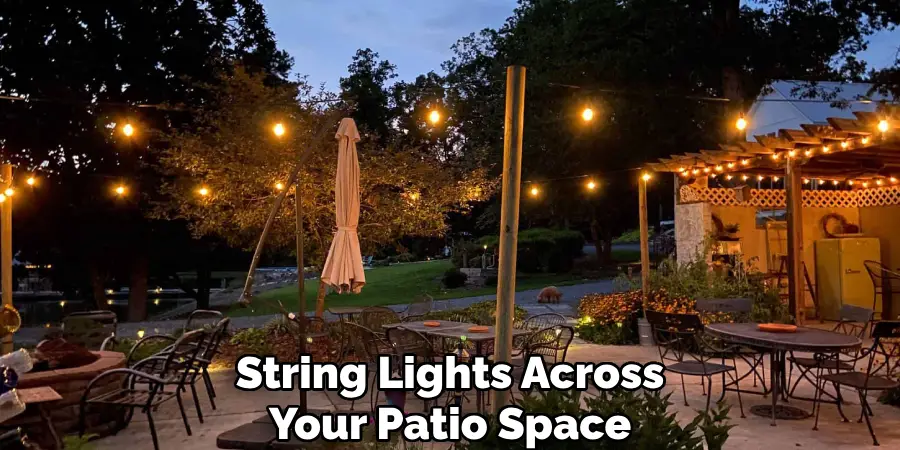
Maintenance and Upkeep
Keeping your patio light setup neat and functional requires regular maintenance and a few simple considerations. Start by inspecting the lights and fastenings periodically, especially after adverse weather conditions, to ensure all components remain secure and intact. Replace any burnt-out bulbs promptly to maintain a consistent visual effect and ensure safety.
Clean the light fixtures and any mounts or hooks with a damp cloth to remove dust or debris, which can accumulate and affect their operation over time. Additionally, check for any frayed wires or corrosion, particularly in zip ties or metal hooks, that could pose a risk.
Store seasonal lighting in a dry place when not in use to extend their lifespan and be proactive in replacing any components that show signs of wear. Regular upkeep not only ensures aesthetic appeal but also prolongs the life of your outdoor lighting arrangement, allowing you to enjoy a beautifully illuminated space year-round.
Troubleshooting Common Issues
Even the best patio lighting setups can encounter a few hitches. Here’s how to address some common issues:
1. Lights Won’t Turn On: First, check the power source and ensure all connections are secure. Verify that the outlet is functioning by plugging in a different device. If the outlet works, inspect the wiring for any visible damage, and replace blown fuses or burnt-out bulbs.
2. Lights Flicker: Flickering lights can be caused by loose connections or faulty bulbs. Double-check that all plugs and connectors are firmly in place. If the issue persists, swap out the bulbs one by one to identify the malfunctioning piece.
3. Uneven Light Distribution: This could result from uneven spacing or tangled wires. Adjust the placement of hooks, zip ties, or clips to create more uniform light spacing. Untangle the lights and arrange them neatly along the intended path.
4. Lights Are Dim: Ensure that the bulbs used are of sufficient brightness for outdoor use. If they appear dim, cleaning the bulbs and addressing any power supply issues can make a significant difference. Additionally, confirm the lights are not overloaded on a single circuit.
5. Waterproofing Concerns: If lights are exposed to rain or moisture, ensure they are rated for outdoor use. Consider using outdoor extension cords, and possibly seal connections with electrical tape. Regularly inspect and replace any damaged weatherproof components.
Conclusion
Incorporating creative solutions for hanging and maintaining patio lights can transform any outdoor space into a welcoming and enchanting atmosphere. Whether you’re setting up for a festive gathering, a quiet evening, or simply wish to enhance your backyard’s ambience, the variety of methods available ensures there’s something suitable for every home and situation. Thanks for reading, and we hope this has given you some inspiration on how to hang patio lights without nails!

